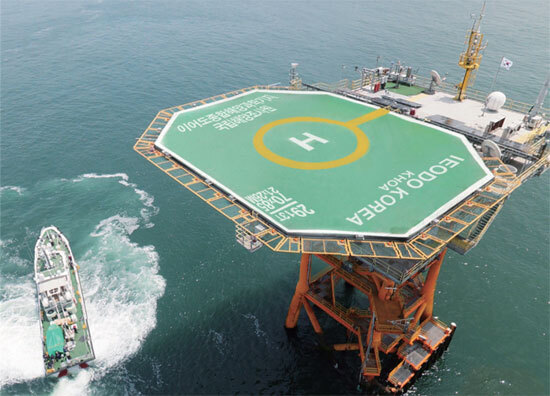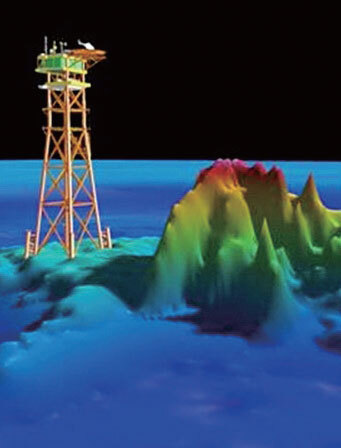Korean Ver.
▶‘이어도’는 전설의 섬이 아니다

- from ‘fIeodo’by ChungJoon Lee
There is a fantasy island where residents of Jeju island longed to visit. For them, the island was an imaginary world that gave people hope to get away from their tough lives. Furthermore, it was an island where people believed that their parents and sons are still alive and residing there. It is Ieodo, an island that appears among legends of Jeju island.
An official name for Ieodo is 'Parangdo.' According to a legend, Ieodo was an imaginary world, and at the same time, it was the island of the dead. Thinking of those people who went out to sea to support their lives and those who lost their lives at sea, 'Ieodo' might be a refuge and comforting figure for left ones who lost their loved ones at sea.
Since the second half of last year, a legendary island 'Ieodo' has been gathering massive attentions from three major Asian countries; South Korea, China, and Japan. It is was not because of the aesthetic value found in literature nor a legendary story. Ieodo drew attentions of the Asian countries due to 'The Air Defense Identification Zone (ADIZ),'
an another symbolic figure that can represent the power of nations in the region.
In last November, as China declared its Chinese Air Defense Identification Zone(CADIZ) with the inclusion of the airspace of Ieodo, countries including Korea, the U.S and Japan started to pay special attentions to this issue.
Especially for the S. Korean government, which is now practically controlling the airspace around Ieodo thanks to the previously built Ocean Research Station around Ieodo by its nation, the declaration from Chinese government may bother the S. Korean government.
Based on what intentions did China include the airspace of Ieodo in its Chinese Air Defense Identification Zone(CADIZ)?
In addition, why didn't the S. Korean government include the airspace of Ieodo in its own Air Defense Identification Zone? After the provocative action was taken from China, the Korean government is having repercussions due to its lenient attitude towards the controversial issue.
◆Ieodo, is submerged rock not territory
To be exact, Ieodo is not a territory that could be claimed as a nation's territory with jurisdiction. In order to be regarded as an official territory, an island must be surrounded by water and should be a land that was created naturally. Furthermore, an island must be above water permanently. In regards with the definition of an island, Ieodo is a submerged rock, not a territory of a nation.
Ieodo, a submerged rock, is located 4.6 meters below sea level. Furthermore, based on the 40 meters below the sea level, the rock has the width of 600 meters from the north to the south and 750 meters from the west to the east. It shows a steep slope in eastern and southern side of the Ieodo and moderate slope in northern and western part of the rock.
Ieodo was also called as Scotra Rock and it was named after a ship that firstly discovered Ieodo.
In 1938, with the purpose of constructing seafloor transmission facilities and lighthouses, Japan was planning to set up an artificial structures made with concrete that has 15 meters in diameter and the height of 35 meters. However, the plan was demolished due to the outbreak of the Pacific War.
It was 1951 when the actual existence of Ieodo, long been an imaginary and legendary island, started to be identified as an actual figure. The Korean Alphine Club and the ROK Navy, which were in charge of territory research project at that time, jointly explored Ieodo and identified its actual figure despite of facing high tides. They placed a cooper plate on its submerged rock. Afterwards Jeju Univ.-KBS Parangdo research team identified the location of the rock once more in 1984 and its depth of water, 4.7 meters, was measured by a research ship of National Oceangraphic Research Institute in 1986.
The first structure placed in Ieodo was a light buoy by the Korea Maritime and
Port Administration in 1987 and this was internationally declared.

◆Declaring new KADIZ in 62 years with Ieodo
After China declared its Chinese Air Defense Identification Zone(CADIZ) over
the airspace of Ieodo, the South Korean government scrambled to include the airspace of Ieodo as Korea Air Defense Identification Zone(KADIZ), thus criticized by people as a "late" response. It was an action taken in 62 years and could be regarded as 'mending the barn after the horse is stolen.' Then, why the S. Korean government did not include the airspace of Ieodo as its Korea Air Defense Identification Zone(KADIZ)?
Regarding this matter, Mr. Kwon (Ph.D in Law), a senior research fellow at Korea Oceanographic and Technology Institute, said "KADIZ was set 62 years ago and it was declared by the US Pacific Command(PACOM). Furthermore, there was an attempt by the South Korean government to include Ieodo in its KADIZ via a government announcement from the Ministry of National Defense(MND)." He also explained, "...since it could lead Japan to include Dokdo islets in its JADIZ, as a result, the announcement was decided not to be made."
He added, "It is disappointing since a resolute external responses and adjustments were not made by the S. Korean government since Japan's JADIZ also included the airspace of Ieodo, even before the declaration of CADIZ by China." Mr. Kwon also said, "From the perspectives of national defense and security issues, it seems that the relationship between the U.S. played a partial role."
As it was mentioned previously, disputes over Ieodo are not about territorial disputes but about the delimitation of maritime boundaries between S. Korea and China. In other words, areas near Ieodo overlap for both S. Korea and China in terms of the delimitation and a consent was already made by the both countries' foreign ministries in 2006."
Regarding the issue of having a jurisdiction on Ieodo by the S. Korean government, Mr. Kwon said, "Ieodo is located from both countries less than 400 nautical miles away and both countries could also be regarded as having a same continental shelf in their maritime territories.
In other words, it is possible to determine the delimitation of maritime boundaries by using mid-line method which considers special circumstances rather than considering geographical and geological factors.
“l He also emphasized saying, "Despite the consideration of diverse factors from both countries' claims, since the relevant region is clearly belongs to the S. Korea's exclusive economic zone, it is natural for the S. Korean government to control Ieodo even before the delimitation. In addition, he added, "Since the delimitation issue was not solved yet, fisheries from the region are accessible to both countries' citizens.

◆Why Ieodo matters? Overlapping Air Defense Identification Zone among S. Korea, China, and Japan
One of the reasons that Japan provokes S. Korea by mentioning Dokdo islets as its own territory is due to rich fishery and maritime resources around the region. The dispute over Ieodo is in line with the same context. Mr. Kown explained that "It is highly likely that those interests from S. Korea, China, and Japan on Ieodo were created due to a strategic importance of the region in terms of military and availability. Ieodo is often regarded as a major area that could be used as China's deep sea policy and utilization its Naval forces."
Furthermore, he added, "As this region can be used as a defense line for Japan to minimize the influence from China, thus, Ieodo is not just a dispute over the jurisdiction. It is exacerbating the dispute as an essential space for both countries to secure the initiative in Northeast Asia." Anyways, S. Korea became a nation stuck in the middle of dispute between two superpowers' power game. Thanks to the interests from Japan and China over Ieodo, Ieodo itself became the Air Defense Identification Zone for all three nations.
Regarding this matter, Mr. Kwon said, "The overlap of ADIZ by all three nations could trigger a crisis in the region depending on the future relationship between China and Japan, which is unstable now. Ieodo is not a region relevant to issues of maritime jurisdiction nor sovereignty over islands. However, because of the power game outside of this disputed region, it is possible that areas around Ieodo could be used as a venue for the extension of power game and the test site for conflicts." In addition, he added that, "In these days, Northeast Asia are directly related to conflicts created from each country to seize its own power and initiative such as conflicts between the U.S. and China, China and Japan, or China - the land state, and Japan -the maritime state, and the U.S."
Last year, as the Chinese government included Ieodo in its Air Defense Identification Zone, the South Korean government suffered in pains once before. A miserable truth is that the S. Korean government had the time of 62 years to include Ieodo in KADIZ. It is impossible to know why Ieodo was not selected as KADIZ, whether it was due to the ignorance of the S. Korean government or the government couldn't do anything because of surrounding countries' influences.
However, I want to ask myself that if China did not include Ieodo in its CADIZ, would Ieodo also be included in KADIZ or not. To make Ieodo not a legendary island again, from now on, I hope the S. Korean government and S. Koreans to pay more attention to what already belongs to S. Korea and keep in mind to protect them.
Boundary delimitation (or simply delimitation) is the drawing of mutual boundaries, based on international law when territorial waters and sea bottom areas were overlapped by multiple nations. It is different from setting a limit for a jurisdiction area for territorial waters and sea bottom areas. Especially, delimitation of areas such as exclusive economic zone and continental shelf is closely related to the distribution of maritime resources, it is likely to trigger international disputes. (21 century politics dictionary)
Air defense identification zone (ADIZ):
An Air Defense Identification Zone (ADIZ) is an airspace over land or water by an Air Force of a nation for the interest of national security and it is normally declared by a nation unilaterally. The concept of ADIZ is different from the airspace and it is not prohibited by international law.
by Paek Eun-Young(angel@newscj.com)
translated by Hur Misun

